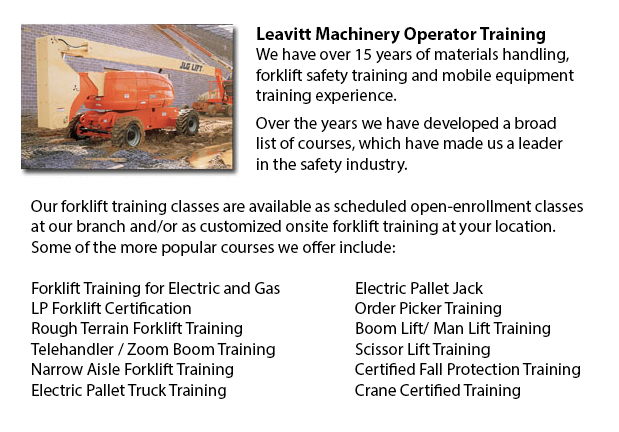
Brampton Boom Lift Safey Training - Boom lifts fall under the kind of aerial lifting device or elevated work platform. Most usually used in construction, industry, and warehousing; the boom lift is really versatile that it can be utilized in practically whatever surroundings.
Elevated work platforms enable workers to get into work areas that will be inaccessible otherwise. There is inherent risk in the operation of these devices. Workers who operate them have to be trained in the right operating procedures. Avoiding accidents is paramount.
Boom Lift Training Programs include the safety factors involved in using boom lifts. The program is suitable for people who operate self-propelled boom supported elevated work platforms and self-propelled elevated work platforms. Upon successfully completing the course, People who participated will be given a certificate by someone licensed to confirm completing a hands-on assessment.
Industry agencies, local and federal regulators, and lift manufacturers all play a part in establishing standards and providing information so as to help train operators in the safe utilization of elevated work platforms. The most essential ways to avoid accidents associated to the utilization of elevated work platforms are the following: checking machinery, wearing safety gear and conducting site assessment.
Vital safety considerations when operating Boom lifts:
Operators stay away from power line, observing the minimum safe approach distance (MSAD). Voltage could arc across the air to be able to find an easy path to ground.
A telescopic boom should be retracted prior to lowering a work platform in order to maintain stability as the platform nears the ground.
Personnel working from the Boom lift platform should tie off to guarantee their safety. Safety harness and lanyard combinations must not be attached to any anchorage other than that provided by the manufacturer, never to other wires or poles. Tying off may or may not be required in scissor lifts, that depends on specific employer guidelines, job risks or local regulations.
The maximum slope would be specified by the manufacturer. Workers must avoid working on a slope, whenever possible. When the slope exceeds recommended situation, the lifting device should be transported or winched over the slope. A grade could be easily measured by laying a straight edge or board of at least 3 feet on the slope. Next a carpenter's level can be laid on the straight edge and raising the end until it is level. The per-cent slope is obtained by measuring the distance to the ground (likewise called the rise) and dividing the rise by the length of the straight edge. After that multiply by one hundred.
-
Brampton Aerial Boom Lift Ticket
Brampton Aerial Boom Lift Ticket - Aerial lift trucks might be used to accomplish several different tasks executed in hard to reach aerial places. Many of the tasks associated with this style of jack include performing routine maintenance on building... More -
Brampton Aerial Lift Train the Trainer
Brampton Aerial Lift Train the Trainer - The Aerial Lifts Train the Trainer Certification Program would teach trainers how to efficiently train operators in safe industrial mobile equipment operation. Trainers are provided with in-depth instruction o... More -
Brampton Zoom Boom Training
Brampton Zoom Boom Training - Zoom Boom Training is intended to train operators on variable reach forklifts. The goals of the training are to be able to impart an understanding of the physics of the machinery, and to be able to outline the operator's... More -
Brampton Heavy Equipment Operator Training
Brampton Heavy Equipment Operator Training - Heavy equipment operator training facilities that provide good standards within the industry, providing field performance work and additional machinery training are really sought after training features. S... More -
Narrow Aisle Forklift / Order Picker Training / Electric Pallet Jack / Electric Pallet Truck Training in Brampton
A pallet haul is equipment built in particular for moving pallets of irregular weights and dimensions. They may be used in conjunction with cranes, forklifts and other heavy duty equipment as an appendage piece or to be employed on their own. Pallet... More -
Brampton Overhead Crane Safety Training
Brampton Overhead Crane Safety Training - Overhead crane safety training equips operators with knowledge and skills regarding crane safety measures, accident avoidance, materials handling, and equipment and stock protection. Trainees will learn the k... More -
Brampton Crane Safety Training
Brampton Crane Safety Training - Companies and crane drivers have to know the problems associated to crane safety. Legislation provides rules for the safe maintenance, operation and inspection of lifting machines across North America. Crane Safety co... More -
Brampton Telehandler Training
Brampton Telehandler Training - Telescopic handlers normally known as telehandlers for short, are a really popular piece of heavy construction machinery. They are usually utilized in the construction and agricultural trades. These machines have farth... More

Forklift Certification Brampton
TOLL FREE: 1-888-254-6157
Brampton, Ontario
forkliftcertificationbrampton.com
Email Us
About Us


